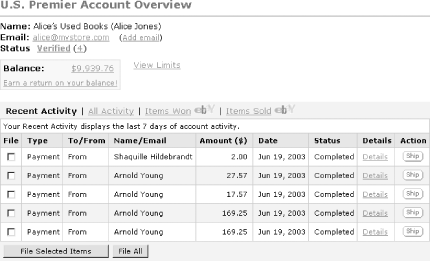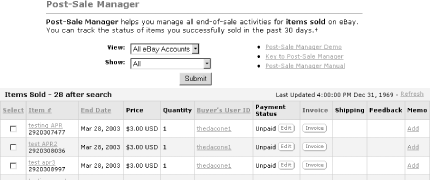Hack 25 Protect Yourself from Chargebacks
| < Day Day Up > |
Hack 25 Protect Yourself from Chargebacks Reduce or eliminate the risk of having disputed payments reversed from your PayPal account . A chargeback is the result of a credit card charge being rejected by the credit card holder, typically in cases where the credit card was stolen and used fraudulently. But such charges can also be disputed by customers who feel that they've been defrauded by sellers. If you accept credit cards, in person or through PayPal, you might encounter a chargeback from a buyer, just as a seller accepting personal checks might receive an occasional bad check. Chargebacks are an unfortunate but realistic cost of doing business, so most sellers factor this cost into their business plans. When a customer initiates a chargeback with his or her credit card company, PayPal may deduct the amount of the transaction from your account if you're not covered under PayPal's Seller Protection Policy [Hack #24] . All sellers who accept credit card payments run this risk and might be liable for chargebacks.
Of course, none of this applies to non-credit card transactions, such as payments funded by a bank account transfer or PayPal balance. 3.13.1 Protecting YourselfWhereas most merchant account providers and payment companies simply pass all of the chargeback risks and associated fees and liabilities on to sellers, PayPal is different. As long as you follow PayPal's guidelines (the Seller Protection Policy outlines these guidelines), PayPal helps protect you against fraudulent chargebacks. Be sure to familiarize yourself with this policy; click the User Agreement link on the bottom of any page on the PayPal web site, and then click Seller Protection Policy. When you follow the policy's guidelines strictly , PayPal protects you from chargeback liability on all qualified transactions. In addition, PayPal takes chargeback claims seriously and, when appropriate, investigates and vigorously contests chargebacks on your behalf .
Here are some best practices you should follow to prevent chargebacks from occurring:
3.13.2 Shipping ProductsWhen a customer disputes a transaction (e.g., files a chargeback) with her credit card company for an unauthorized charge or undelivered item, the first item of information the credit card company will expect from PayPal (and you) when disputing the chargeback is proof that the customer received the merchandise. Providing verifiable proof that the customer received the item in question does not mean simply being able to prove that you shipped the merchandise. You must also prove that the package was delivered and, if applicable , signed for. To that end, you should always use a shipping service that provides some type of online package tracking.
Use the PayPal Shipping Tool by clicking the Ship button in your transaction history, as shown in Figure 3-6. Figure 3-6. Using the PayPal Shipping Tool This way, your customer's shipping information is automatically inserted into the shipping label (saving you time), and the resulting shipment tracking information is automatically stored along with the transaction details (streamlining any subsequent chargeback defense), as shown in Figure 3-7. Figure 3-7. Tracking any package shipped with the PayPal Shipping Tool If you don't use the PayPal Shipping Tool, you can still provide PayPal (and your customers) with your tracking information. Just open the transaction in your account history and click the Add button next to Shipment Tracking Information. Among other things, this feature will also eliminate a large portion of customer complaints and possible disputes filed prematurely by impatient or otherwise confused customers for nondelivery of items. For eBay auctions, use PayPal's Post Sale Manager (located under the Auction Tools tab of your account) to help manage shipments, as shown in Figure 3-8. Figure 3-8. Using PayPal's Post-Sale Manager to manage shipments for eBay sales 3.13.3 Responding When You Receive a ChargebackUnfortunately , no matter what steps you take during the transaction process, you still might receive a chargeback. Whether it is due to nonreceipt of an item, an item not as described, or a transaction that was reported as unauthorized, it can happen to you. The first step when you receive a chargeback notification is to make sure that you respond with accurate information and do so within the requested timeframe. This allows PayPal to effectively dispute the chargeback case on your behalf. Keeping good records of transactions and shipment of goods and communications, as described earlier in this hack, will make this an easy task.
When a chargeback is first received, PayPal places a temporary hold on the associated funds in your account until PayPal is able to investigate the transaction and determine whether you're covered under the Seller Protection Policy. This does not mean your PayPal account will be debited; rather, it means the funds are, in essence, frozen and that a reversal is pending , which means that you cannot withdraw or otherwise use those funds. Upon review of your case (which can take up to 30 days), either of the following can happen:
As soon as PayPal notifies you of a chargeback, open the Transaction Disputes page by logging into your PayPal account and clicking the Resolution Center tab (or by going to https ://www.paypal.com/SRVCTR). Next, select Open Disputes to go to the transaction in question, and click the Resolve button in the action column. Read the status details of the complaint and click the Resolve Chargeback Now button. At this point, you'll have three options:
Click Continue and follow the instructions provided. 3.13.4 Providing Additional Information About Your CasePayPal welcomes any additional information that might aid the dispute process; the information that might be helpful depends on the type of chargeback you're fighting:
If, at any time, you discover additional information pertinent to an open case, you should send it through PayPal's secure web server. Simply log in to the PayPal web site, click Contact Us at the bottom of any PayPal page, and then click Contact Customer Service. When completing the Ask Your Question web form, make sure to include the chargeback case ID number (e.g., PP -xxx-xxx-xxx ) in the subject line of the Transaction Disputes page. This allows PayPal's Chargeback Department to quickly associate the response with the appropriate case. If you are unable to provide all of the information you have through the PayPal web site, you can send an email to chargeback-response@paypal.com. Again, be sure to include the PayPal chargeback case ID in the subject line.
When sending emails to PayPal, keep in mind that you will not be able to include attachments. However, if you need to provide additional documentation that cannot be described easily in an email, you can fax additional chargeback dispute information to PayPal's Chargeback Department at (402) 537-5755. Of course, you should always include your PayPal Case ID as a reference. |
| < Day Day Up > |
EAN: 2147483647
Pages: 169

